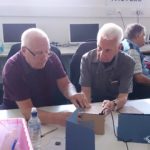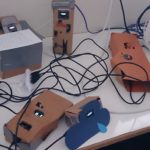The first activities of Performing the Future took place in Liverpool – exhibiting The Prediction Machine for 3 months at FACT in Liverpool as part of the New Observatory exhibition (that included some of the most exciting interactive/digital artists in the UK such as Thomson and Craighead, Stanza and Proboscis) and I was also honoured to be invited back to work with the Digital Ambassadors at FACT, who I had worked with two years ago on The Prediction Machine.
Performing the Future is taking place across England, with Liverpool as my starting point I am traversing several different regions, urban and rural settings to have conversations and collaborate on experiments looking at how we can envisage positive futures in the face of environmental change.
When I returned to Liverpool to meet with the Digital Ambassadors I was hosted at a locally based artist’s house – Nina Edge. Her house has been turned into a public artwork covered in Tigers and bulldozers in response to the destruction of the Welsh Streets around her house. The roads surrounding her home are boarded up and appear bleak despite a sense of a strong community that is both ghostly and real, with residents like Nina holding out and continuing their lives. It seemed like an appropriate start for my journey, a stark vision of urban regeneration stuck at the point of transition. A vision that could be post-apocalypse or the beginning of a utopian renewal, a street devoid of life…
The workshops marked the beginning of my conversations on environmental change and looking towards the future. It seemed important to begin by talking to the older generation (over-60s). To talk about the changes they have witnessed. Here progress was a big focus. The past, the present and the future was about experiencing progress. Most of the participants said they grew up without electricity, quite a few agreed with each other that their childhood memories were mainly cold, no heating, cold winters… nearly all of them agreed that the thing they had most gained in their lifetimes was electricity. This was the start of some interesting discussions on the impact of the incredible impact this had on their lives and the world as a whole, particularly in terms of environmental impact.
There was a lot of discussion also about jobs, security and quality of life.
One of the participants had been carrying his prediction from The Prediction Machine in his wallet for 2 years (since the artwork had previously been exhibited at FACT). The prediction was that he would ‘ retire early and enjoy the warming coastal waters of the North’, he said that he had already retired early but in the last 2 years had been going on holiday all around the North of England with his girlfriend and had found it mainly very warm and sunny.
Another participant became really involved in the workshop and started a diary between the two workshops (with a week in between them), tracking the weather and researching climate change. Him and his friend started to do research on the impact of climate change on the migration of humans and animals as a result of the discussions – with immigration also being a point of discussion and some contention in the group.
By the end of the workshop each group built their own ‘mini prediction machines’, prototype machines that tracked the live weather and were designed to send messages about things that were changing in the world as they changed. The themes the groups chose were migration due to climate change, bird species declining, warming sea temperatures and changes to the local weather in Liverpool. They conducted their own research into what data they wanted to be shown on the machines, built the prototypes and designed the casings for the machines.
At a later date the group’s facilitator Neil Winterburn continued this work, working with them to develop the casings for the machines. He also took the machines to another senior group in Liverpool and ran his own workshop with the technology.





















